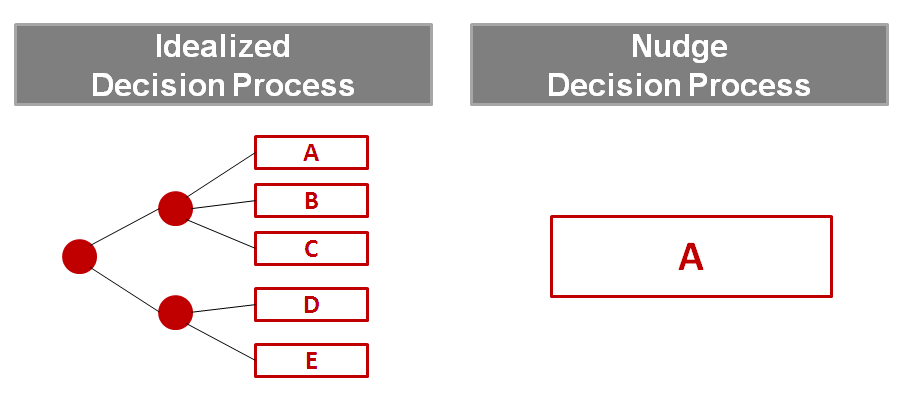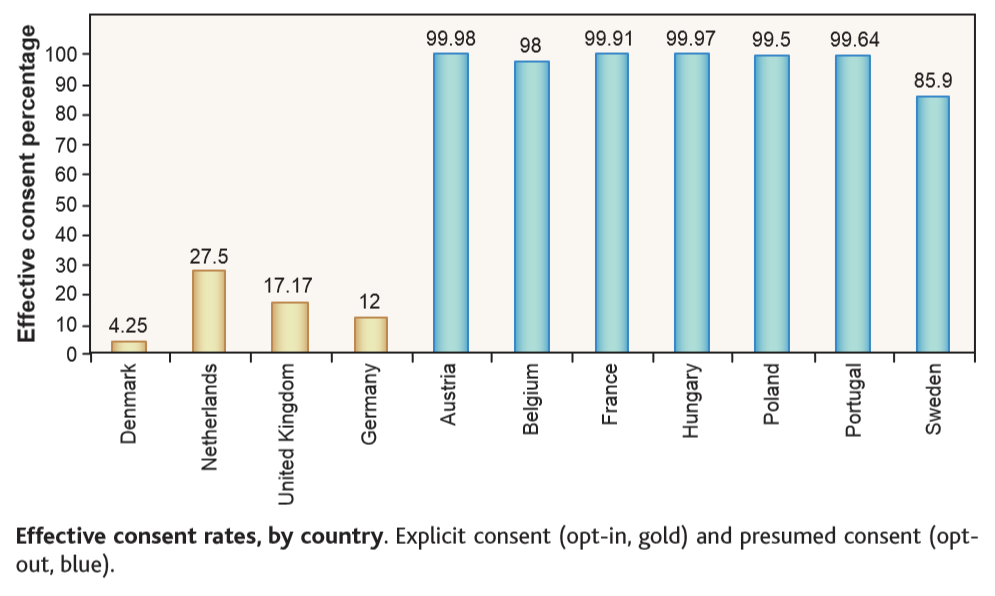Idealized Decision-Making Process
On the left, you can see what an idealized thought process might look like. Linear and orderly. The decisions are measured and distinct. Depending on the probabilities and payoffs, you can choose: A, B, C, D, E.
Human Decision-Making Process
On the right, you can see what happens a lot. We only see one option – due to our preconceived notions, laziness, or even eagerness to fit in. There is a myopia in decision-making because, well frankly, we are human.

Choice Architecture
Nudge was written by two University of Chicago professors – Richard Thaler and Cass Sunstein – who argue that people can be nudged to make better decisions with more thoughtful “choice architecture.” The way the choices are displayed and the default options heavily influences the outcome. See an excerpt from their book and 12 nudges here.
At face value, it’s not a radical concept
If you have read Paco Underhill’s Why We Buy (affiliate link), you know that there is a lot of science and psychology in the placement of products at retail stores. The best-marketed products are placed at eye-level and aisle end-caps so they catch the shopper’s attention. Consumer product companies pay $ millions in slotting fees to get good shelf space.
No design is neutral
They contend (and I agree) that there is no such thing as a neutral design. Something has to be on the front of the menu, something has to eye-level in the grocery store, something has to the default shipping preference on amazon.com. If any configuration of choices has a slant or bias, why not do the homework . . . and present the choices so that people tend to pick the “better” one?
Policy makers love this stuff
You can see why this is an attractive idea. It respects the libertarian ideas of choice and individual responsibility, while also suggesting that governments/ institutions can subtly tilt people’s choices towards better decisions. It is the rare type of solution that has some appeal to tea-party Republicans and big-deal Democrats alike. It’s gotten lots of traction from policy makers in many countries.
Default Choice
There are dozens of reasons that we have faulty judgment, but this post will only talk about one of them – default choice. The concept is simple enough; default choice is the option that is selected if you do nothing. It is the status quo option.
Because we are ambivalent – default choice
Interestingly, the #1 ringtone is the default one provided by Verizon, AT&T and Sprint. Not the prettiest sound, but some people such as my parents just can’t be bothered to change it. After all, it’s a small and trivial thing. No real value there and the default option works.
Because we are lazy – default choice
Being ambivalent on something minor like a ringtone seems plausible, but what if I told you people did the same thing with their 401(k) and 403(b) retirement plans? 30-40 years of stocking away $$ from your pay check is certainly not trivial. It’s a non-decision that can cost $ hundreds of thousands.
In Nudge, they discuss a somewhat depressing study conducted with CALPERS, the gargantuan pension fund for California state teachers. CALPERS found out that the average number of times that teachers changed their asset allocation (% of stocks, bonds, cash) of their portfolio during their careers . . . .wait for it. . . . was 0 times.
That means that more than 50% of people in that pension did not ever change their asset allocation. Essentially, they started teaching at 25 years old with some generic allocation in stocks / bonds / cash, and they stuck with that generic setting for 15-40 years. Why gamble your retirement on what someone in HR chose as the default choice for the 401K? Yikes.
Because we don’t pay attention – default choice
A study from 2003 showed that the % of the population who donated organs was highly correlated to the default option on the driver’s license. If the default was YES, 85%+ people donated their organs at death. If the default was NO, most people did not donate. In the graph below, the blue color represents countries that assumed you would donate (default choice) or you had to opt-OUT.

So what does this mean to consultants?
All this business-book talk is fine, but what does this mean to consultants and their clients?
#1. Coach your clients on default choices
For those focused on sales and marketing projects, coach your customers to think through the choice architecture. The options that your clients show their end customers matter. Google is uniquely aware of this and paid Mozilla (creator of Firefox) to have Google as its default search engine. Of course Google argued to regulators that other search browsers were only 1 click away – but you and I know that people don’t take that extra step.
#2. Put your best recommendation first
When you storyboard your recommendations, and present options, put the best one first. The order of the options matter. Don’t bury your best thought in the middle of the deck. Put your best foot forward.
#3. Expect resistance to change
Don’t forget that your client’s organization has a default choice too. The status quo option for them is to NOT listen to you. It is easier for them to do nothing, take the default choice, and ignore the changes you are recommending. It is not enough to argue with logic (head). You have to provide the passion (heart) which motivates them to act, and give them the tools (hand) to make it easy to repeat and implement the change. Persuade by using head, heart and hand.
#4. In sales, use the assumptive close
A well-known, and proven tactic in closing the sale with a client is called the “assumptive close.” It goes like this.
You have vetted the client, know their needs, and believe in good conscience that your product/service is needed. The client is hesitant or just indecisive. Judging on the situation and your selling style, just proceed as if they agreed to buy. Essentially, you are giving them the default choice of buying from you – unless they tell you otherwise.
As strange as it sounds, it works. In a previous life, I was a stockbroker and there is nothing as raw as selling stocks. “Mr. Smith, sounds like this is a good fit for you, and you are interested in XYZ. I will put you down for 100 shares at the market price, okay?”
#5. Beware of default choices
As a consultant, a good part of your job is to see past the default choices that the client’s organization has convinced itself of over the last 50 years. They have oral history, precedents, and institutional memory. Things we hear:
- “We can’t do that, we tried that before” [default choice]
- “They VP will never agree to that” [default choice]
- “We have never done that type of project before” [default choice]
#6. Look for opt-in and opt-out marketing
Once you open your eyes to it, you will see default choices everywhere, even on this blog.

I really liked these lessons that you drew from Nudge. I’ve learned a little bit of Behavioral Economics over the past few years, and it certainly seems like something that consultants could apply. If you haven’t heard of him, I’d also recommend Dan Ariely’s books. I found Predictably Irrational (http://tinyurl.com/by37dua) to be excellent.
Joseph, thanks for the comment. Yes, I believe that the entire field of behavioral economics is on fire. So many books touch on the topic. . .maybe it is a bit of disillusionment from the inherently irrational things that keep going on (e.g., financial crisis, huge housing bubble etc). Here is another list of those type of books: http://www.goodreads.com/shelf/show/behavioral-economics
I have not read Predictably Irrational, but saw him on TED and he pops up on NPR and MarketPlace podcasts all the time. Will have to add that to my list.
There were a lot of other points that NUDGE made, but it was WAY too much to put into 1 post. Have to weave those into other posts – without boring people.
You are right: too much good information for one post. I look forward to seeing what you write in the future.